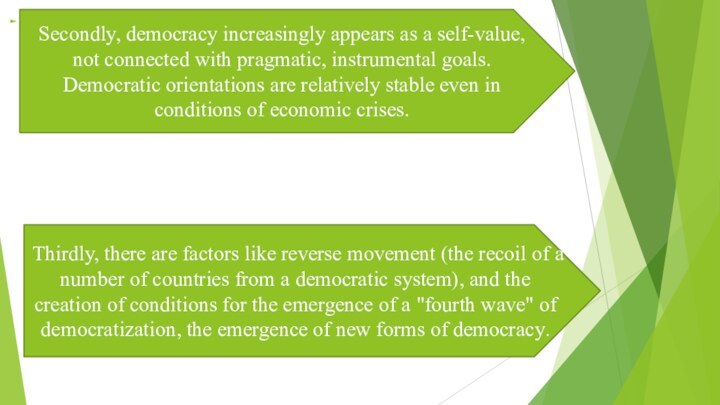- Главная
- Разное
- Бизнес и предпринимательство
- Образование
- Развлечения
- Государство
- Спорт
- Графика
- Культурология
- Еда и кулинария
- Лингвистика
- Религиоведение
- Черчение
- Физкультура
- ИЗО
- Психология
- Социология
- Английский язык
- Астрономия
- Алгебра
- Биология
- География
- Геометрия
- Детские презентации
- Информатика
- История
- Литература
- Маркетинг
- Математика
- Медицина
- Менеджмент
- Музыка
- МХК
- Немецкий язык
- ОБЖ
- Обществознание
- Окружающий мир
- Педагогика
- Русский язык
- Технология
- Физика
- Философия
- Химия
- Шаблоны, картинки для презентаций
- Экология
- Экономика
- Юриспруденция
Что такое findslide.org?
FindSlide.org - это сайт презентаций, докладов, шаблонов в формате PowerPoint.
Обратная связь
Email: Нажмите что бы посмотреть
Презентация на тему The theory of waves of democratization of S. Huntington
Содержание
- 2. The theory of waves of democratizationThe theory
- 3. .The first, long, wave 1820-1926. Its rise
- 4. .The second, short, wave 1943-1962. The outbreak
- 5. Third waveThird wave 1974-1991. In fact, the
- 6. .орSecondly, democracy increasingly appears as a self-value,
- 7. S. HuntingtonThe "third wave" of democratization,
- 8. Скачать презентацию
- 9. Похожие презентации








Слайд 3
.
The first, long, wave 1820-1926. Its rise was
influenced by the American and French revolutions, the emergence
of "states-states" and the democratization of the British dominions. Characteristic features are: 50% of the adult male population should have the right to vote; the executive head of the executive branch must either retain the support of the majority in the elected parliament or be elected in the course of periodic popular elections.
Слайд 4
.
The second, short, wave 1943-1962. The outbreak of
the Second World War and the allied occupation influenced
the establishment of democratic institutions in West Germany, Italy, Austria, Japan and Korea. Some countries returned to democracy, for example, Uruguay, who abandoned it during the rollback of the first "wave." The democratization of Africa began, Nigeria was the first.
Слайд 5
Third wave
Third wave 1974-1991. In fact, the third
"wave" of democratization begins with the fall of the
Portuguese dictatorship and dictatorships in Southern Europe, Asia and Latin America. The end of decolonization, the fall of the communist world and the collapse of the USSR all led to the emergence of new democracies.The concept of the "third wave" of democratization is based on the following basic assumptions:
Firstly, due to the global nature of the transition to democracy, the form and intensity of democratic processes in individual countries are increasingly influenced by the international factor. Democratization also covers the sphere of international relations, reducing the likelihood of wars between states.
Слайд 6
.
ор
Secondly, democracy increasingly appears as a self-value, not
connected with pragmatic, instrumental goals. Democratic orientations are relatively
stable even in conditions of economic crises.Thirdly, there are factors like reverse movement (the recoil of a number of countries from a democratic system), and the creation of conditions for the emergence of a "fourth wave" of democratization, the emergence of new forms of democracy.





























